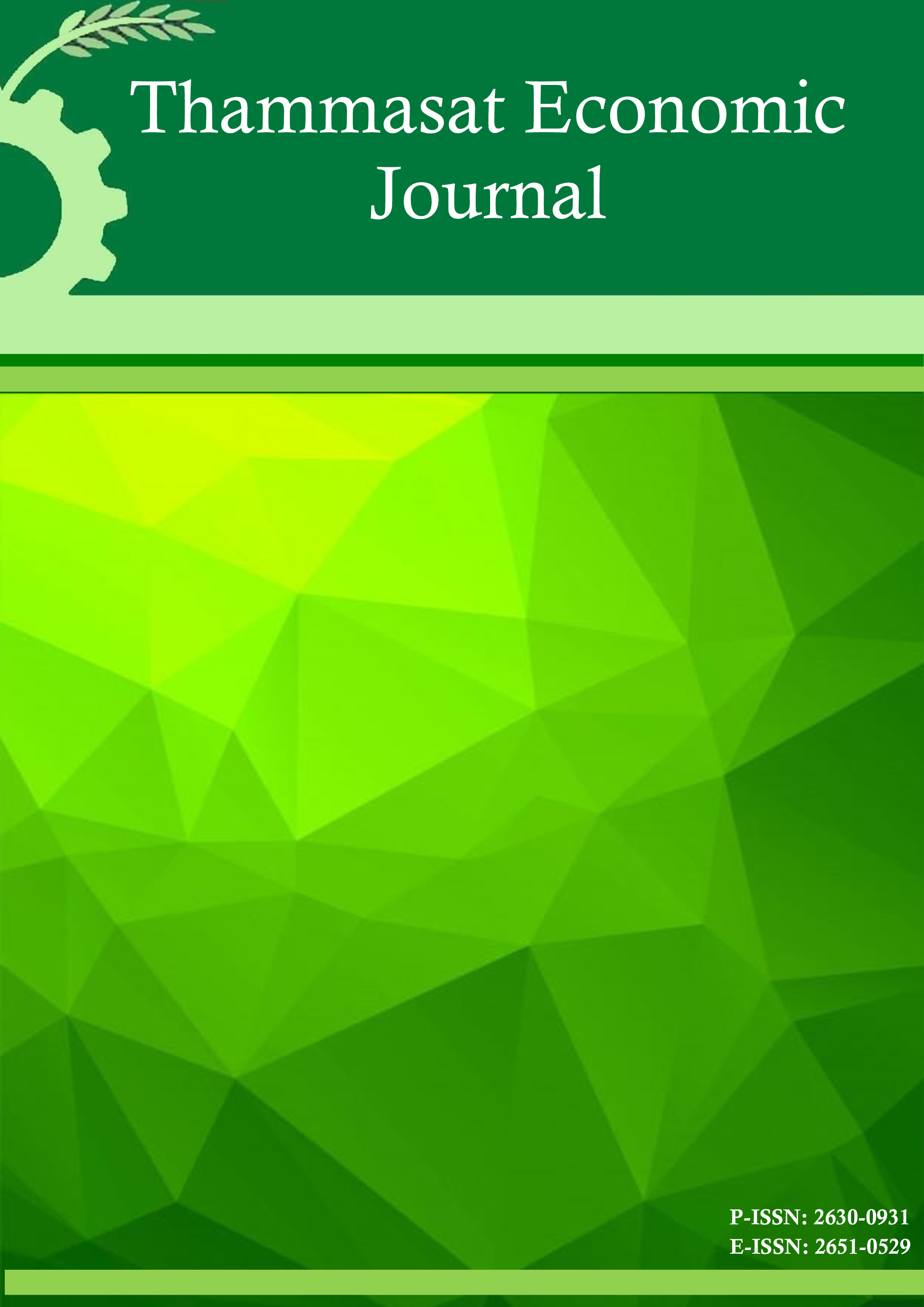ปัจจัยที่กำหนดทิศทางการปรับเปลี่ยนอัตราดอกเบี้ยนโยบายของธนาคารกลาง ภายใต้เป้าหมายอัตราเงินเฟ้อ
บทคัดย่อ
วัตถุประสงค์ของการศึกษานี้เพื่อศึกษาปัจจัยที่มีอิทธิพลต่อทิศทางการปรับเปลี่ยนอัตราดอกเบี้ยนโยบายและผลของการเปลี่ยนแปลงปัจจัยทางเศรษฐกิจเชิงมหภาคที่มีต่อโอกาสในการปรับเปลี่ยนอัตราดอกเบี้ยดังกล่าว เนื่องจากอัตราดอกเบี้ยนโยบายมีการเคลื่อนไหวในลักษณะไม่ต่อเนื่อง งานศึกษานี้จึงอาศัยแบบจำลองโพรบิตแบบเรียงลำดับในการอธิบายและพยากรณ์ร่วมกับกฎของเทย์เลอร์ โดยใช้ข้อมูลอนุกรมเวลาแบบรายเดือนของประเทศเกาหลีใต้ ไทย และฟิลิปปินส์ ตั้งแต่ มกราคม ค.ศ. 2000-กรกฎาคม 2011 ผลการศึกษาบ่งชี้ว่าปัจจัยที่ส่งผลกระทบต่อการปรับเปลี่ยนอัตราดอกเบี้ยนโยบายของธนาคารกลางประเทศต่างๆ เป็นไปตามกฎของเทย์เลอร์ อย่างไรก็ตาม ปัจจัยทางการเงินระหว่างประเทศอื่นๆ นอกเหนือจากช่องว่างของอัตราเงินเฟ้อ อัตราการขยายตัวของผลผลิตและอัตราแลกเปลี่ยน ได้แก่ ระดับราคาน้ำมันโลก อัตราดอกเบี้ยนโยบายของสหรัฐฯ และปริมาณเงินเป็นอีกหนึ่งปัจจัยที่นำมาพิจารณาในการกำหนดอัตราดอกเบี้ยนโยบายของประเทศไทยและฟิลิปปินส์ ภายใต้การเปิดเสรีทางการเงินระหว่างประเทศ เมื่อพิจารณาผลของการเปลี่ยนแปลงของปัจจัยทางเศรษฐกิจที่จะมีอิทธิพลต่อโอกาสในการปรับเปลี่ยนอัตราดอกเบี้ยนโยบาย พบว่า การตอบสนองของอัตราดอกเบี้ยนโยบายต่อการเปลี่ยนแปลงปัจจัยต่างๆ ในประเทศเกาหลีใต้มีผลค่อนข้างต่ำ ในขณะที่โอกาสในการปรับเปลี่ยนอัตราดอกเบี้ยนโยบายของประเทศไทยและฟิลิปปินส์ต่อการเปลี่ยนแปลงของอัตราดอกเบี้ยนโยบายสหรัฐฯ มีผลค่อนข้างสูงเมื่อเปรียบเทียบกับปัจจัยอื่นๆ ผลการศึกษาครั้งนี้คงเป็นแนวทางหนึ่งที่ทำให้หน่วยเศรษฐกิจต่างๆ เข้าใจการดำเนินนโยบายการเงินของธนาคารกลาง ในขณะที่ฝ่ายผู้ดำเนินนโยบายซึ่งต้องเผชิญกับความซับซ้อนของการดำเนินนโยบายการเงินอาจต้องให้ความสำคัญต่อการสื่อสารเพื่อสร้างความเข้าใจต่อสาธารณชนมากยิ่งขึ้น เพื่อนำมาซึ่งความน่าเชื่อถือและความโปร่งใสอันเป็นหัวใจที่สำคัญ ประการหนึ่งของกรอบเป้าหมายอัตราเงินเฟ้อ
References
1.Greene, W. H. (2003). Econometric Analysis. 5th ed. Upper Saddle River, NJ: Prentice Hall.
2.Heij, C., De Boer, P., Frances, P. H., Kloek, T., & Van Dijk, H. K. (2004). Econometric Methods with Applications in Business and Economics. New York: Oxford University Press.
3.Long, J. S. (1997). Regression Models for Categorical and Limited Dependent Variables. Thousand Oaks, CA: Sage Publications.
Verbeek, M. (2004). A Guide to Modern Econometrics. 2nd ed. New York: John Wiley & Sons.
4.Walsh, C. E. (2003). Monetary Theory and Policy. 2nd ed. Massachusetts: MIT Press.
Article in Journal:
1Boes, S. (2007). Three essays on the econometric analysis of discrete dependent Variables. Unpublished doctoral dissertation, Universität Zürich, Faculty of Economics.
2.Butler, J. S., & Moffitt, R. (1982). A Computationally efficient quadrature procedure for the one-factor multinomial probit model. Econometrica, 50, 761-764.
3.Caetano, S., & Silva, G. Jr. (2007). Dynamics of the SELIC interest rates target in Brazil. Economics Bulletin, 5(19), 1-12.
4.Caglayan, E., & Astar, M. (2010). Taylor rule: Is it an applicable guide for inflation targeting countries?. Journal of Money, Investment and Banking, 18, 55-67.
5.Calvo, G. A., & Reinhart, C. M. (2002). Fear of floating. Quarterly Journal of Economics, 117, 379-408.
6.Clarida, R., Gali, J., & Gertler, M. (2000). Monetary policy rules and macroeconomic stability: Evidence and some theory. Quarterly Journal of Economics, 115, 147-180.
7.Davutyan, N., & Parke, W. R. (1995). The operations of the bank of England 1890-1908: A dynamic probit approach. Journal of Money, Credit and Banking, 27, 1099-1112.
8.Eichengreen, B., Watson, M., & Grossman, R. S. (1985). Bank rate policy under the interwar gold standard: A dynamic probit approach. Economic Journal, 95, 725-745.
9.Elliott, G., Rothenberg, T. J., & Stock, J. H. (1996). Efficient tests for an autoregressive unit root. Econometrica, Econometric Society, 64, 813-836.
10.Gerlach, S. (2007). Interest rate setting by the ECB, 1999-2006: Words and deeds. International Journal of Central Banking, International Journal of Central Banking, 3(3), 1-46.
11.Gorter, J., Jacobs, J., & Haan J. d. (2008). Taylor rules for the ECB using expectations data. Scandinavian Journal of Economics, 110, 473-488.
12.Greene , W. H., & Hensher, D. A. (2008). Modeling ordered choices: A primer and recent developments [Working Papers 08-26]: New York University, Leonard N. Stern School of Business, Department of Economics.
13.Hayo, B., & Neuenkirch, M. (2009). Canadian interest rate setting: The information content of Canadian and U.S. central bank communication. [MAGKS Papers on Economics 200935]: Philipps-Universität Marburg, Faculty of Business Administration and Economics, Department of Economics.
14.Heinemann, F., & Ullrich, K. (2007). Does it pay to watch central bankers’ lips? The information content of ECB wording. Swiss Journal of Economics and Statistics (SJES), 143, 155-185.
15.Hu, L., & Phillips, Peter C. B. (2004). Dynamics of the Federal funds target rate: A nonstationary discrete choice approach. Journal of Applied Econometrics, 19, 851-867.
16.Jansen, D.-J., & Haan, J. D. (2009). Has ECB communication been helpful in predicting interest rate decisions? An evaluation of the early years of the Economic and Monetary Union. Applied Economics, 41,1995-2003.
17.Judd, J. P., & Rudebusch, G. D. (1998). Taylor's rule and the Fed, 1970-1997. Economic Review, Federal Reserve Bank of San Francisco, 3, 3-16.
18.Kim, H., Jackson, J., & Saba, R. P. (2009). Forecasting the FOMC's interest rate setting behavior: A further analysis. Journal of Forecasting, 28(2), 145-165.
19.Kim, T.-H. , Mizen, P., & Chevapatrakul, T. (2008). Forecasting changes in UKinterest rates. Journal of Forecasting, 27, 53-74.
20.Kwiatkowski, D., Phillips, P. C. B., Schmidt, P., & Shin, Y. (1992). Testing the null hypothesis of stationarity against the alternative of a unit root: How sure are we that economic time series have a unit root? Journal of Econometrics, 54, 159-178.
21.Lapp, J. S., Pearce, D. K., & Laksanasut, S. (2003). The predictability of FOMC decisions: Evidence from the Volcker and Greenspan chairmanships. Southern Economic Journal, 70(2), 312-327.
22.Luangaram, Pongsak, Sethapramote, Yuthana, & Sirisettaapa, Pimolrat. (2009, November). An evaluation of inflation forecast targeting in Thailand. BOT Research Workshop 4-6.
23.Mehra, Y. P., & Sawhney, B. (2010). Inflation measure, Taylor rules, and the Greenspan-Bernanke years. Economic Quarterly, Federal Reserve Bank of Richmond, 96(2), 123-151.
24.Mishkin, F. S. (2007). Headline versus core inflation in the conduct of monetary policy: a speech at the Business Cycles, International Transmission and Macroeconomic Policies Conference, HEC Montreal, Montreal, Canada, Oc. Speech, Board of Governors of the Federal Reserve System (U.S.).
25.Moura, M. L., & de Carvalho, A. (2010). What can Taylor rules say about monetary policy in Latin America?. Journal of Macroeconomics, 32, 392-404.
26.Newey, W. K., & West, K. D. (1994). Automatic lag selection in covariance matrix estimation. Review of Economic Studies, Wiley Blackwell, 61, 631-653.
27.Ng, S., & Perron, P. (2000). Lag length selection and the construction of unit root tests with good size and power. Econometrica, 69, 1519-1554.
28.Phillips, Peter C. B., Jin, S., & Hu, L. (2007). Nonstationary discrete choice: A corrigenda. Journal of Econometrics, 141, 1115-1130.
29.Rosa, C. (2009). Forecasting the direction of policy rate changes: The importance of ECB words. Economic Notes, 38, 39-66.
30.Rudebusch, G. D. (2002). Term structure evidence on interest rate smoothing and monetary policy inertia. Journal of Monetary Economics, Elsevier, 49(6), 1161-1187.
31.Ruth, K. (2007). Interest rate reaction functions for the euro area. Empirical Economics, 33, 541-569.
32.Sack, B., & Wieland, V. (2000). Interest rate smoothing and optimal monetary policy: A review of recent empirical evidence. Journal of Economics and Business, 52, 205-228.
33.Svensson, Lars E. O. (1997). Inflation forecast targeting: Implementing and monitoring inflation targets. European Economic Review, 41, 1111-1146.
34.Taylor, J. (1993). Discrete versus policy rules in practice. Carnegie–Rochester Series on Public Policy, 39, 195-214.
35.Woodford, M. (2001). The Taylor rule and optimal monetary policy. American Economic Review. 91, 232-237.






